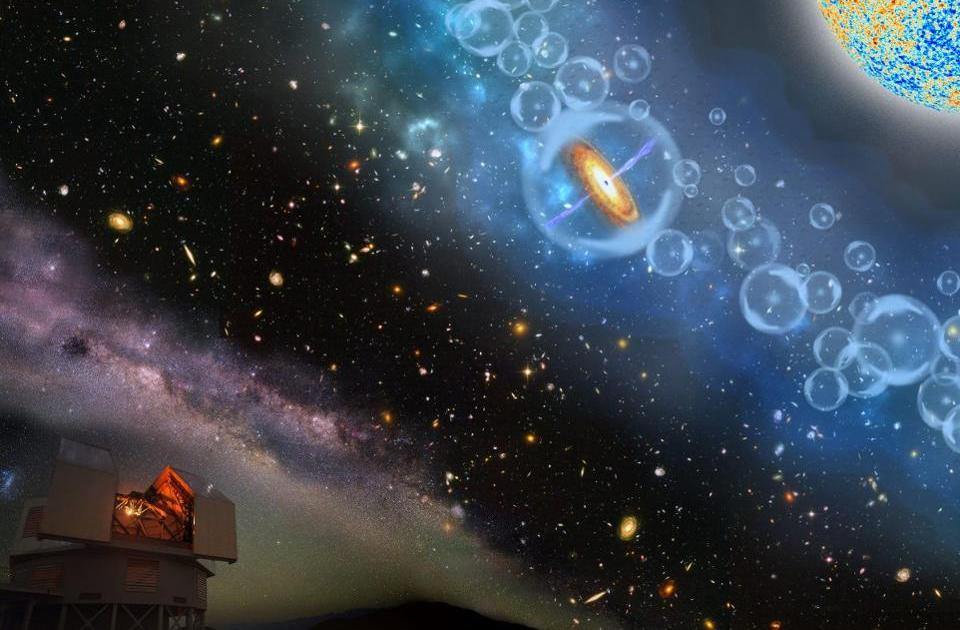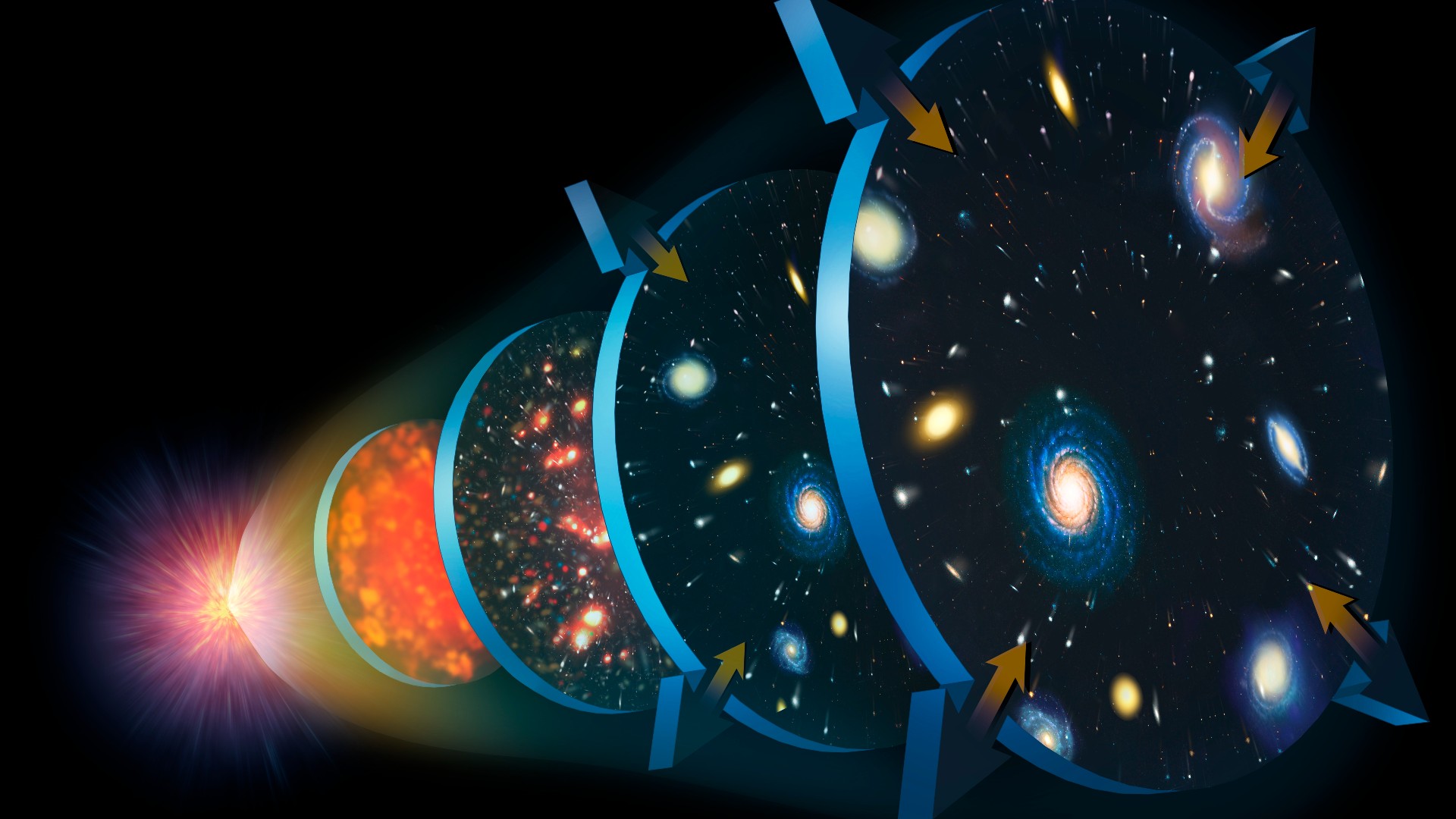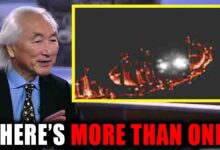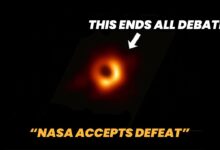Where Is Everything In The Universe Going?

**In the 1970s, astronomers discovered that our Milky Way galaxy is moving, pulled toward an invisible force.** However, its ultimate destination is hidden by the “avoidance zone” — an area of the sky obscured by the Milky Way’s dust and gas, making it invisible to us. Like a small boat being tossed about in a vast ocean on a moonless night, we are moving toward an unknown destination, and we are not alone. Not only is our Milky Way moving, but all of our neighboring galaxies are moving too.
**Astronomers Arand Tully and J. Richard Fischer, using the Parks radio telescope in Australia, have been surveying distant galaxies.** They have been trying to reconstruct the motions of galaxies from early observations. At the same time, other teams are observing cosmic microwave radiation — a trace of the Big Bang. From independent observations by both groups, scientists have detected the first signs of a large cosmic flow.
**The galaxies that Tully and Fischer examined seem to have a common point, with their speeds of movement all pointing in a particular direction.** Cosmic microwave radiation, on the other hand, shows a difference in temperature across the sky, hotter in one direction and colder in the opposite direction. Some of this difference can be explained by the movement of the Sun around the center of the Milky Way, but even when this is removed, there is still an unexplained part of the movement. We are moving at speeds of up to hundreds of kilometers per second, as if the Milky Way and the surrounding galaxies are being pulled toward a particular point in the universe, a point that we cannot see or locate.

**We call it the “Great Cosmic Gravity,” an invisible force that pulls the Milky Way and thousands of other galaxies toward it.** This is a common phenomenon in the universe, because the universe is always in a state of constant motion. Everything in the universe is moving, from the rotation of the Earth around the Sun, to the movement of the Sun through the Milky Way, to the movement of the Milky Way toward the Great Cosmic Gravity.
**The Great Cosmic Gravity is just the tip of the cosmic iceberg, with structures and movements far greater than anything we have ever observed before.** The universe is not static; everything is moving in some direction, and this movement raises the question: Where are we moving?
**On September 23, 1999, the Mars Climate Orbiter spacecraft lost contact with NASA as it approached the planet.** After investigation, the cause was determined to be a unit conversion error between metric and imperial units. This is an example of how even billion-dollar projects can fail because of simple errors.
**Our universe is always in motion, and the way scientists describe the history of science is a process of increasingly deeper understanding of the motion of the universe.** For millennia, European and Middle Eastern astronomers believed that the Earth was motionless and that everything in the universe revolved around it. However, this system of motion was imperfect and quite confusing. Ptolemy’s old system of small circular orbits superimposed on larger orbits around the Earth could not explain everything. Therefore, **Nicolas Copernicus, in 1543, published “De revolutionibus orbium coelestium”**, a new theory with the Sun at the center of the universe, and the Earth and other planets revolving around it.
**However, Copernicus’s theory was no simpler than the old system, and it created many new questions, such as how to feel the Earth’s movement?** Although the Earth moves rapidly, we do not feel it. It was not until the 17th century, with Isaac Newton’s theory of gravity, that we were able to explain why we do not feel the Earth’s movement.
**With Einstein’s theory of Relativity, we understood that there is no “fixed frame of reference” to measure all motion. ** Instead, all motion is relative, and can only be measured based on comparison with other objects.

**The Earth’s motion in the larger universe is a much more complicated story.** We need a different frame of reference to measure our motion. And fortunately, the universe gives us the necessary tool. The universe is not static, it is expanding, and it is this expansion that allows astronomers to determine the motion of galaxies relative to the universe.
**With this tool, astronomers have begun to better understand the motion of the Earth, the Sun, the Milky Way, and other galaxies in the universe.** This motion is not just the rotation of the Earth around the Sun, but also the movement of the Solar System within the Milky Way and the Milky Way’s movement toward the Great Cosmic Gravity.
In approximately 2 billion years, the Milky Way and Andromeda galaxies will start to collide. As they draw closer, their immense gravitational forces will distort and reshape both galaxies. This interaction is similar to the ocean tides on Earth, where the parts of each galaxy closest to the other will experience stronger gravitational pulls than other regions. This causes tidal forces, which can stretch parts of the galaxies, sometimes even detaching spiral arms, forming what’s known as tidal tails—a long stretch of stars and intense star formation that can extend for tens of thousands of light years. As the galaxies get closer, a bridge of gas and stars may form between them, as though they are reaching out to each other.
However, when the actual merger occurs, around 5 billion years from now, it won’t be a violent crash like a car accident. The majority of the volume of each galaxy is empty space, so the stars will mostly pass by one another without colliding. Instead, the gas in the galaxies will collide and form shock waves, creating complex disturbances. Though the stars won’t collide, they will come close enough to disrupt each other’s orbits, leading to chaotic movements within the galaxies. Over time, the galaxy’s flat discs will give way to a tangled mess of stars, overlapping orbits, and star formations.
During the initial stages of the merger, the intense gravitational forces will trigger bursts of star formation. In some regions of the newly merged galaxy, stars could form at a rate a thousand times greater than the current rate. For a brief moment, the merged galaxy will appear spectacularly bright, lit by millions of newborn stars shining brightly in blue and white. However, this burst of star formation will soon come to an end. The gas that fueled it will be used up quickly, and there won’t be enough gas left to create more stars. Eventually, the galaxy will transition into a red, star-poor elliptical galaxy known as “Milcomoda” by some astronomers. This type of galaxy has limited star formation and will eventually fade into a quiet existence, with long-lived dwarf stars remaining.
These predictions are based on simulations, but some recent studies suggest that the merger might not happen for another 8 billion years, if at all. Galaxy mergers take hundreds of millions of years, and astronomers can’t directly observe them in real-time. Instead, they study snapshots of galaxies at various stages of interaction. For example, galaxies like the M galaxies (290 million light-years away) and ARP 220 (250 million light-years away) are currently undergoing mergers, showing evidence of intense star formation triggered by gravitational interactions.
The process of galaxy mergers has been ongoing for billions of years, long before the galaxies we see today even existed. Our Milky Way, along with the Andromeda galaxy, is part of a larger group of galaxies called the Local Group. These galaxies, including the Triangulum and smaller dwarf galaxies, will continue to interact and merge over billions of years. Eventually, the Local Group will collapse into a single, more massive galaxy.
The study of these mergers, along with mathematical models, allows astronomers to predict the future of the Milky Way. For instance, the Great Attractor, a massive gravitational force, is pulling the Milky Way and other nearby galaxies towards it. The expansion of the universe also allows astronomers to create detailed velocity maps of galaxies to understand their movement.
One of the key tools in studying this is the cosmic microwave background (CMB), which was created when the universe was about 380,000 years old. The CMB provides a snapshot of the early universe and serves as a reference for understanding the movement of galaxies today. The CMB is uniform, but slight variations in temperature can show how galaxies are moving. This “dipole” effect—where one direction of the sky appears slightly hotter than another—reveals that the Milky Way is moving at around 600 km per second. After accounting for the movement of the sun and the upcoming merger with Andromeda, this motion is still directed toward the Great Attractor.
This entire process of galaxy merging is a fundamental part of the universe’s evolution. It shows how galaxies have formed over billions of years, through countless mergers and interactions, creating the hierarchical structure we see today. Groups of galaxies, such as the Local Group, will continue to collapse and merge, growing larger and larger over time. This process of hierarchical structure formation is one of the key mechanisms by which the universe has evolved from its early, simpler state to the complex cosmic structure we observe today.








